
|
|
 |
|
|
|
|
|
|
|
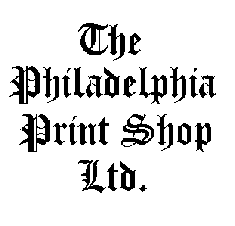
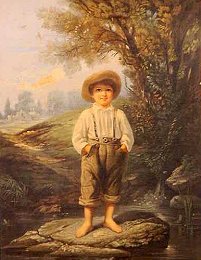
Louis Prang, from Boston, was the most prolific and influential publisher of American chromolithographs. Born in Germany, Prang learned to print in color from his father, who was a calico printer. He immigrated to the United States in 1850 for political reasons. After a short-lived partnership as a chromolithographic printmaker with Julius Mayer (Prang & Mayer), Prang set up his own firm of L. Prang & Co. in 1860. His initial success came from his many small prints collected by members of the public and kept in albums. By the 1860s, Prang stated to issue color-printed copies of famous paintings and launched his magazine, Prang's Chromo: A Journal of Popular Art. Prang's prints, which were "sold in all Picture stores," were based on oils and watercolors and received highly praised from the press and many influential persons. Prang did more to create the market for chromolithographs in America than any other publisher, and his work also great shaped the output of other publishers around the country. These art prints became hugely successful, with about 800 of them eventually issued by Prang. He advertised them as:
| "PRANG'S AMERICAN CHROMOS. 'THE DEMOCRACY OF ART' . . . Our Chromo Prints are absolute FACSIMILES of the originals, in color, drawing, and spirit, and their price is so low that every home may enjoy the luxury of possessing a copy of works of art, which hitherto adorned only the parlors of the rich." |
A.T. Bricher. "Souvenir of Lake George." Boston: L. Prang & Co., 1866. Chromolithograph. 4 1/2 x 9. Very good condition. Framed.
A handsome image of Lake George issued by Prang to be sold at this site as a souvenir. This is a nice early example of Prang's output. $165
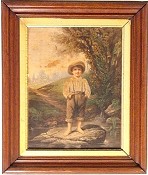


A lovely pair of Prang genre prints. Johnson's "The Barefoot Boy" is one of the most famous of all Prang's chromos, advertised by Prang the personification of the American character, the boy "in homespun clothing, barefooted," symbolizing "that self-reliant aspect which characterizes the rural and backwoods children." This print was based by Eastman Johnson on John Greenleaf Whittier's poem, "The Barefoot Boy." The chromo was praised in magazines and books as the paradigm of what these prints could be, and Prang claimed that it was "the most popular of all our publications." It took three months to make the twenty-six stones used to make this print, and five months to print the first run. For promotion, Prang provided free copies to the poet and painter and then quoted their replies in his advertisements. Whittier wrote, "It is a charming illustration of my little poem, and in every way satisfactory as a work of art," and Johnson claimed that, "It strikes me as being one of the best chromolithographs I have ever seen."
Prang was inspired by the popularity of Johnson's "The Barefoot Boy" to commission a companion image from George C. Lambdin. Lambdin was an artist from Germantown, PA, who later moved to New York City where he was elected an Academician at the National Academy. Lambdin painted genre and military scenes, but later in his life he devoted his time to paintings of flowers. This Lambdin painting shows a shy girl, also barefoot, leaning on a tree and holding a hand-full of grapes. This image, entitled "Wild Fruit," was published as a companion chromolithograph by Prang two years after Johnson's barefoot boy. The prints, in matching period frames, make a lovely pair that beautifully express the ideal image of American youth held by many after the Civil War. These prints also are wonderful examples of the quality of prints published by the greatest of American chromolithograph publishers. $900
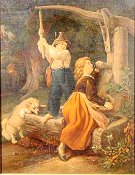
Felix Schlesinger. "A Friend In Need." Boston: L. Prang & Co., 1867. Chromolithograph. Mounted on board with original label. Very good condition. Framed.
This print reflects Prang's own response to the success of "The Barefoot Boy." Based on a painting by a German artist, the European dress and setting would have appealed to the huge potential market of European immigrants, who might not respond to the American paradigm of Johnson's image. $425

Albert Bierstadt. "Sunset: California Scenery." Boston: L. Prang & Co., 1868. 12 x 18. Mounted on canvas as issued. In elaborate period frame with some chipping to decorative gesso at corners. With original label. Some minor surface blemishes, but generally very good.
Prang used the paintings of many of America's leading artists to produce his prints, including those by A.F. Tait, Eastman Johnson, Thomas Moran, F.S. Church, and Albert Bierstadt. In the case of this print, one of the more important ever issued by Prang, he borrowed the painting that was in the possession of "Miss Eliza Bierstadt." The print was sold by Prang for $10 and was described as "one of the best efforts of the artist, and the chromo is also pronounced to be one of the best reproductions ever brought out." This print was very well received, and was considered one of the best reproductions of the work of an important American artist. Indeed, it is a superior example of the quality that chromolithography could achieve. $4,600
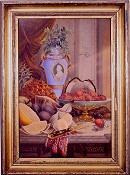
Wilkie (?). Fruit still life. Boston: L. Prang & Co., ca. 1870. Chromolithograph. 15 x 9 3/4. Mounted on board as issued. Very good condition. In original frame. Frame with some typical wear, but still very good appearance.
A very finely done image of a fruit still lfe in a period frame. $450
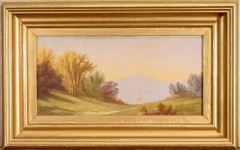
A.T. Bricher. "Mount Chocurua & Lake, New Hampshire." Boston: L. Prang & Co., 1866. Chromolithograph. 4 5/8 x 9 1/4. Mounted on board with original label. Very good condition. In period frame.
A view of Mount Chocurua from Louis Prang based on a painting by A.T. Bricher. $245

After Giraud. "The Two Friends." Boston: L. Prang & Co., 1868. Chromolithograph. Mounted on board with original label. In elaborate period frame.
Here is another print of children in a European style. However, this print was intended by Prang to appeal to a more "sophisicated" audience, for whom the Barefoot Boy and Schlesinger's image were too provincial. Though more "cultured," this is none-the-less an equally charming image by Prang. $725

Eastman Johnson. "The Boyhood of Lincoln. (An Evening in the Log Hut.)" Boston: L. Prang, 1868. Chromolithograph. 21 x 16 3/4. In period frame. Mounted on board as issued and with original label.
Eastman Johnson was hailed for his charming image of the "Barefoot Boy," inspired by on John Greenleaf Whittier's poem. This classic American image was made into a chromolithograph by Louis Prang of Boston. Louis Prang was the most successful American publisher of chromolithographs and he said that the print of the Barefoot Boy was his most successful print ever. This success spurred Prang to go back to Johnson for another of his excellent images, this print showing young Abraham Lincoln reading by the light of a fire in his log cabin home. This is one of Prang's larger and most expensive images, selling for $12 a copy (in contrast to the Barefoot Boy's $5). According to Prang's promotional text, "This great national picture,…is full of artistic excellencies, apart from its associations…What better picture to have constantly before the eyes of the rising generation? It teaches that in America there is no social eminence impossible to the lowest youth, who by perseverance, study, and honesty of life and purpose, shall seek to reach the ranks of the rulers of the people." This print still evokes that American ideal, which in addition to the quality and attractiveness of this superb chromolithograph, makes this a most desirable American print. $2,200

After J.F. Herring. "Just Caught." Boston: L. Prang, ca.1860- 1880's. 7 3/4 x 12 /4. Minor surface abrasions. Otherwise, very good condition. In period frame.
Besides the American sporting images by Tait, Prang issued some British sporting prints, for these were as popular in the nineteenth century as they are today. This bright image based on one of the greatest of the British artists of this genre, J.F. Herring. $450
After Joseph Morviller. "Sunlight in Winter." Boston: L. Prang, ca. 1860- 1870. 16 x 23 1/2. Some surface abrasion, wear, and aged varnish. Fair condition.
A Prang image of a winter scene by American artist Joseph Morviller (1800-187). Despite its condition problems, still an print with considerable appeal. $375
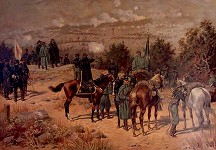
Thure de Thulstrup. "Battle of Chattanooga, November 25, 1863." Boston: L. Prang, 1887. 15 x 21 7/8. Chromolithograph. Slight crease in bottom left, light waterstain top left, and minor chip at top.
A striking image that is one of the rare and important Civil War series issued by Louis Prang between 1886 and 1888. In the early 1880s, Century Magazine had issued a very popular work entitled Battles and Leaders of the Civil War, and the Kurz & Allison firm had issued a large chromolithograph of Gettysburg. In response to these, Louis Prang decided to issue a portfolio of 18 elaborate chromolithographs of important battles of the war. Prang termed his prints "aquarelle facsimile prints" to distinguish them from "mere" chromos. Prang claimed they were made by a "new and secret process", but primarily they were chromos done without any line work. They were based on watercolors commissioned by Prang and they were intended to be naturalistic and accurate, for Prang was aiming these prints for veterans and their descendants. Prang got testimonials on their accuracy from prominent veterans and he included detailed text on the battles involved. The prints were quite popular, helping to create a great surge in patriotic nostalgia about the war.
There were 18 prints in all: 6 of eastern battles; 6 of western battles; and 6 naval images. There was intended to be something for everyone, and Prang focused mostly on heroes who were still living at the time. The were issued either in a portfolio or separately for framing.. At first they were issued in parts over time, but eventually were packaged into three groups: East/West/Naval. These are not to be confused with the more common later Prang chromos, also issued by the American Lithographic Company. Not only are these more finely produced, but they are much scarcer.
This print shows the action at Chattanooga. From the top of a hill, General Ulysses S. Grant uses a field glass to follow the Union assault on Missionary Ridge. Grant is joined by Generals Gordon Granger (left) and George H. Thomas, whose chief of staff would later this image as a "beautiful lifelike picture." Thulstrup's details are noteworthy, from the orderly that holds the general's horses in the foreground to the artillery smoke rising from the distant enemy. $850
![]() Go to listing of other prints from this series of Prang Civil War images
Go to listing of other prints from this series of Prang Civil War images
![]()
For further information call, write, fax or e-mail to:

![]()
8441 Germantown Avenue
Philadelphia, PA 19118 USA
(215) 242-4750 [Phone]
(215) 242-6977 [Fax]
[email protected] ![]()
©The Philadelphia Print Shop, Ltd. Last updated November 18, 2004